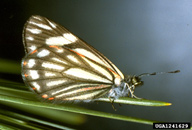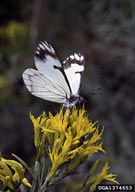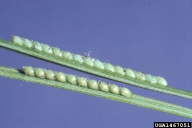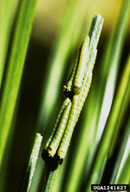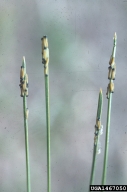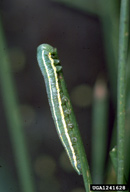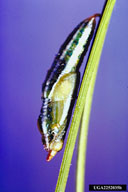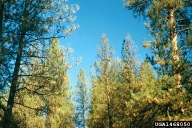Pine butterfly
Neophasia menapia (Felder and Felder) (Lepidoptera: Pieridae)
Orientation to pest
The pine butterfly, Neophasia menapia (Felder and Felder), is a native North American butterfly that is an important pest of ponderosa pine (Pinus ponderosa P.& C. Lawson) in the western United States, where large outbreaks have occurred. Adults fly in late summer and fall, and eggs are laid in rows in groups of 5-20 on current year needles. Eggs overwinter and hatch the following June, or about the time that new needles begin to appear on ponderosa pine. Young larvae eat the old needles first, but new needles are eaten later by older larvae. Larvae attach themselves to needles, twigs, bark, or other objects before pupating. In 2 to 3 weeks, adults emerge and complete the cycle. There is one generation per year. Older trees are more susceptible to injury than younger thriftier trees. Outbreaks usually last 3 or 4 years; most cause little mortality, although intense and widespread outbreaks may result in reduction in tree growth. A few outbreaks have killed extensive stands of older trees when aided by bark beetles.
Hosts commonly attacked
In most areas, this caterpillar feeds mainly on ponderosa pine (P. ponderosa), but during outbreaks other conifers may also be attacked if intermixed with ponderosa pine, such as lodgepole (Pinus contorta Douglas) and western white (Pinus monticola Douglas ex D. Don) pines, Douglas-fir (Pseudotsuga menziesii [Mirb.] Franco), grand fir (Abies grandis [Dougl. ex D. Don] Lindl.), and western larch (Larix occidentalis Nutt.). In the coastal area of northwestern Washington and on Vancouver Island, British Columbia, Canada, outbreaks have occurred in Douglas-fir stands.
Distribution
The butterfly is found throughout the western United States; but outbreaks have occurred primarily in Oregon, Washington, Idaho, Montana, and British Columbia.
Images of pine butterfly
| Figure 1. Adult female (left) and male (right) of pine butterfly, Neophasia menapia | Figure 2. Eggs of pine butterfly |
| Figure 3. Young larvae of pine butterfly | Figure 4. Mature larva of pine butterfly |
| Figure 5. Pupa of pine butterfly | Figure 6. Feeding damage of pine butterfly on ponderosa pines |
Important biological control agents related to this pest species
Several insects, including hemipterans (Podisus spp. and Apoecilus spp.), snakeflies (Raphidia spp.), sarcophagid flies (Agria spp.), and wasps (Ichneumonidae) have been reported preying on different stages of pine butterfly. Decline of the 1922-23 outbreak of this butterfly was attributed to mortality from some of these natural enemies, especially a native ichneumon parasite, Theronia atalantae (Poda).
Web links for information on pine butterfly
- Fact Sheet | Natural Resources Canada
- Pine Butterfly: A sleeping defoliator raises its head! | Master Woodland Managers, Oregon State University Extension
Articles
- Evenden, J. C. 1926. The pine butterfly, Neophasia menapia Felder. Journal of Agricultural Research 33(4): 339-344.
- Evenden, J. C. 1940. Effects of defoliation by the pine butterfly upon ponderosa pine. Journal of Forestry 38(12): 949-955.
- Cole, W. E. 1966. Effect of pine butterfly defoliation on ponderosa pine in southern Idaho. Research Note INT-46. Ogden, UT: U. S. Department of Agriculture, Forest Service, Intermountain Forest and Range Experiment Station. 7 pp.
- Young, R. M. 1986. Mass emergences of the pine white, Neophasia menapia menapia (Felder & Felder), in Colorado (Pieridae). Journal of the Lepidopterists' Society 40 (4): 314.
